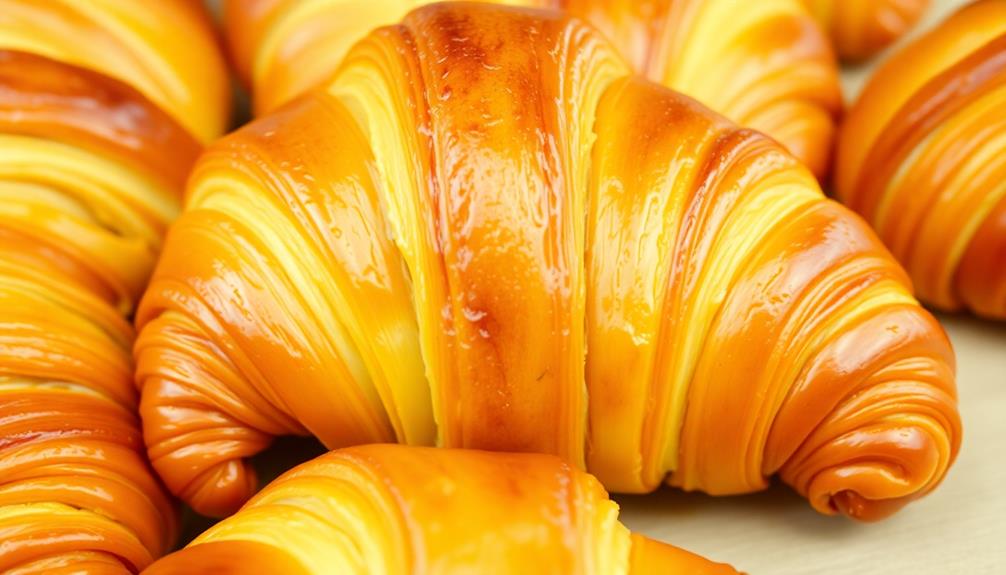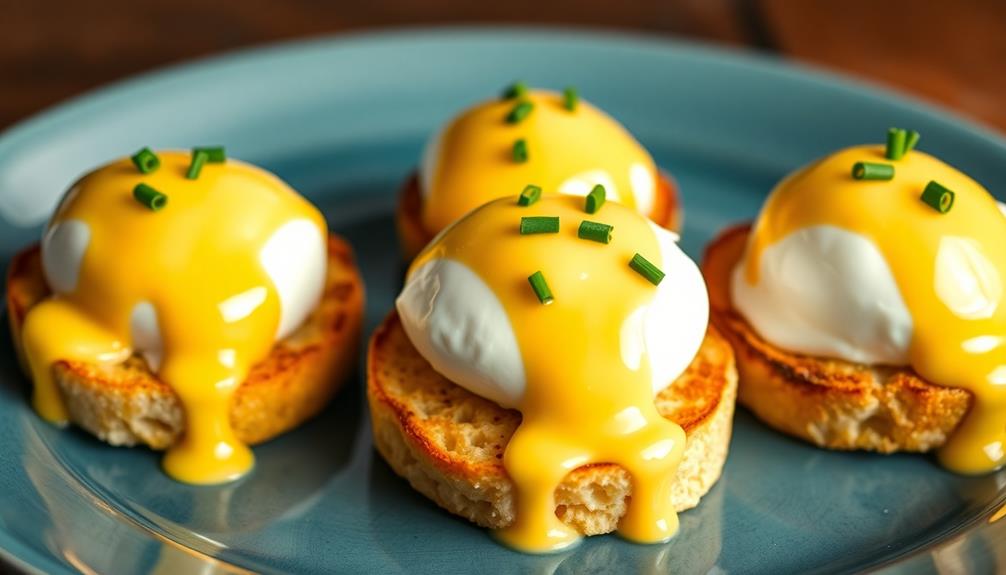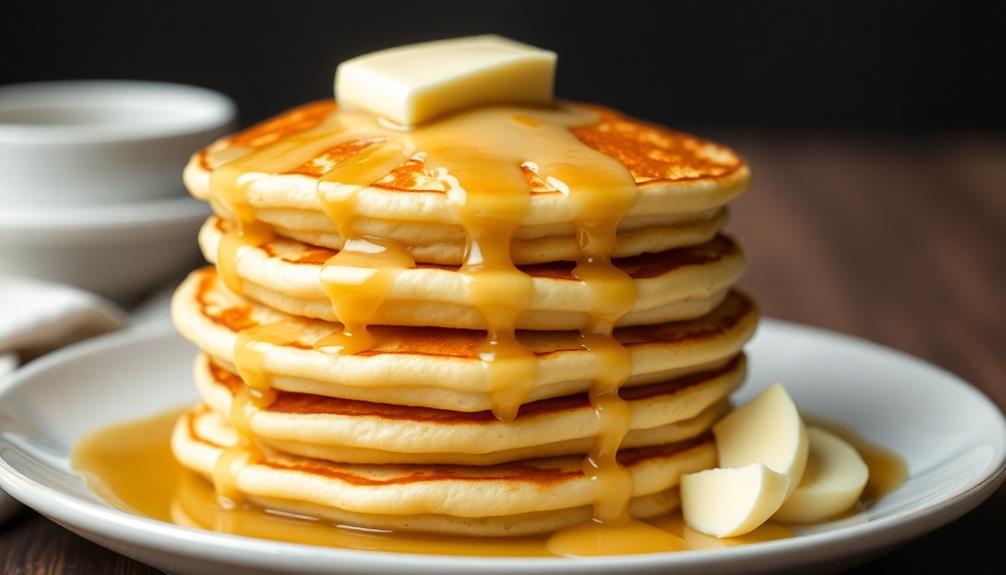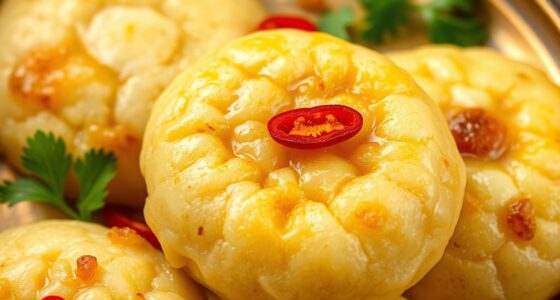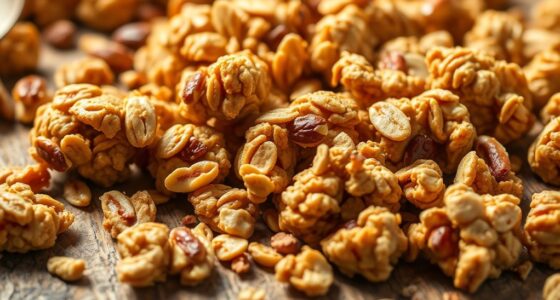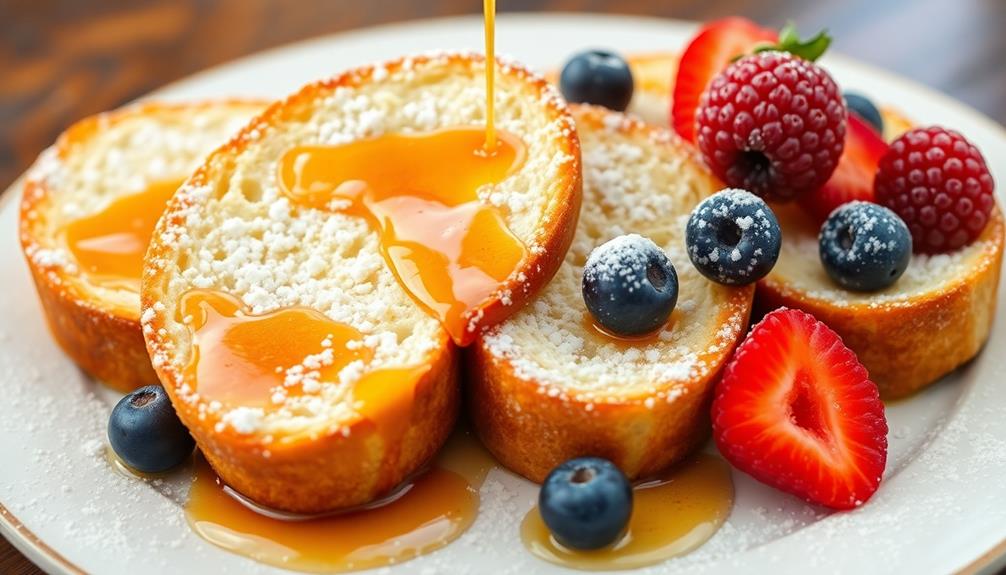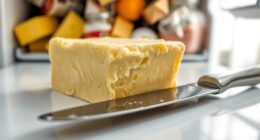Craving a taste of classic French pastry? You're in luck! Croissants originated centuries ago from the Turkish crescent moon symbol, evolving into a beloved French delicacy. The secret lies in the lamination process, creating hundreds of flaky, buttery layers. Start by mixing a yeast-based dough, then fold, roll, and chill repeatedly to develop that signature flakiness. Handle the dough gently and keep all ingredients well-chilled for the best results. Bake until golden-brown, then savor the warm, aromatic wonder. Want to take your croissant-making skills to the next level? Keep reading for more expert tips.
Key Takeaways
- The key to making flaky, buttery croissants lies in the lamination process, which involves repeatedly folding and chilling the dough to create hundreds of delicate layers.
- Precise temperature control for all ingredients, especially the butter, is crucial to maintain the integrity of the layers during the lamination process.
- Handling the dough gently and allowing adequate resting time between steps is essential to prevent overworking and ensure a tender, flaky texture.
- Shaping the croissants with a light touch and maintaining uniform thickness during rolling are important for even baking and maximum flakiness.
- Monitoring the baking process closely and serving the croissants warm are essential for achieving the desired golden-brown color and melt-in-your-mouth experience.
History

The croissant's origins can be traced back to the 1683 Battle of Vienna, where bakers in the city's besieged garrison created a crescent-shaped pastry to celebrate the Austrians' victory over the Ottoman Empire.
This delectable creation was inspired by the iconic Turkish crescent moon on their flags, and it quickly became a symbol of national pride.
Over the centuries, the croissant has evolved from a humble military celebration into a beloved French delicacy, with bakers perfecting the art of creating those perfectly flaky, buttery layers.
Today, the croissant remains a cornerstone of French cuisine, a testament to the ingenuity and culinary expertise that has been passed down through generations.
Whether enjoyed for breakfast, as an afternoon snack, or as a decadent treat, the croissant continues to captivate and delight taste buds around the world.
Recipe
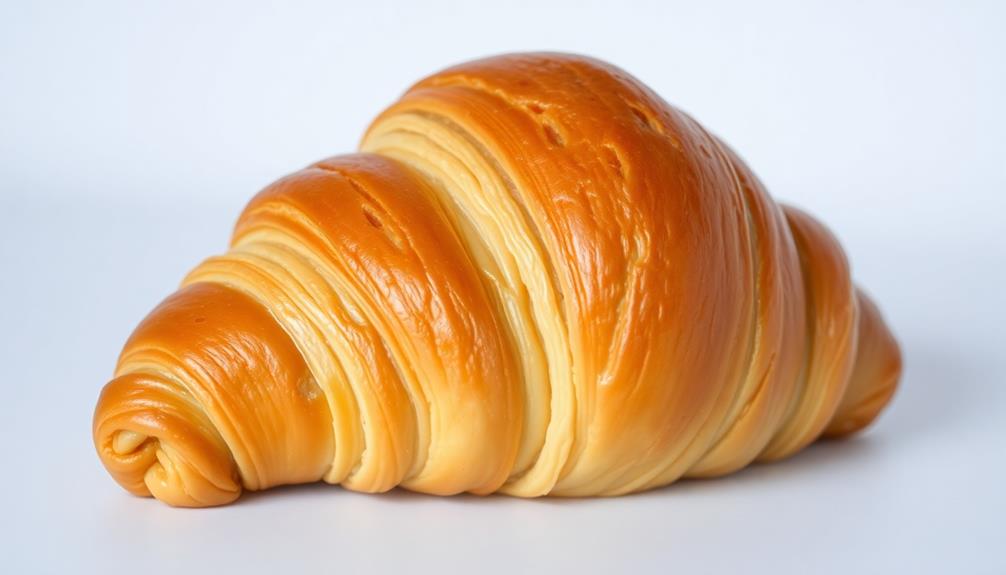
Flaky, buttery croissants are a beloved French pastry that can be enjoyed for breakfast, as a snack, or as a side to a meal. Mastering the art of croissant-making at home may seem daunting, but with the right technique and ingredients, you can create bakery-quality croissants in your own kitchen.
The key to achieving the perfect croissant texture lies in the lamination process, which involves repeatedly folding and rolling the dough to create hundreds of delicate layers of butter and dough. This process may take some time and patience, but the results are well worth the effort.
Ingredients:
- 2 1/4 cups (281g) all-purpose flour
- 2 tablespoons (25g) granulated sugar
- 1 teaspoon (5g) salt
- 1 cup (226g) unsalted butter, chilled and cut into 1/2-inch pieces
- 1 cup (240ml) cold water
- 1 egg, beaten (for egg wash)
Instructions:
In a large bowl, combine the flour, sugar, and salt. Cut in the chilled butter pieces until the mixture resembles coarse crumbs. Gradually add the cold water, mixing just until the dough comes together.
Shape the dough into a disk, wrap in plastic wrap, and refrigerate for at least 1 hour.
On a lightly floured surface, roll the dough into a long rectangle, about 1/4-inch thick. Fold the dough into thirds, like a letter, then roll it out again. Repeat this process 4-5 times, refrigerating the dough for 30 minutes between each folding. This process creates the flaky layers.
After the final fold, cut the dough in half and roll each piece into a long rectangle, about 1/4-inch thick. Cut each rectangle into triangles and roll them up, starting from the wide end and finishing at the point.
Place the croissants on a parchment-lined baking sheet, cover, and refrigerate for at least 30 minutes.
Preheat the oven to 400°F (200°C). Brush the croissants with the beaten egg and bake for 15-20 minutes, or until golden brown. Serve warm and enjoy!
Tips:
- Make sure all your ingredients, especially the butter, are well-chilled before starting. This helps maintain the layers during the lamination process.
- Avoid overworking the dough, as this can result in tough, dense croissants. Handle the dough gently and work quickly to maintain the delicate layers.
- For extra flakiness, consider sprinkling the dough with a light dusting of flour before each fold.
Cooking Steps
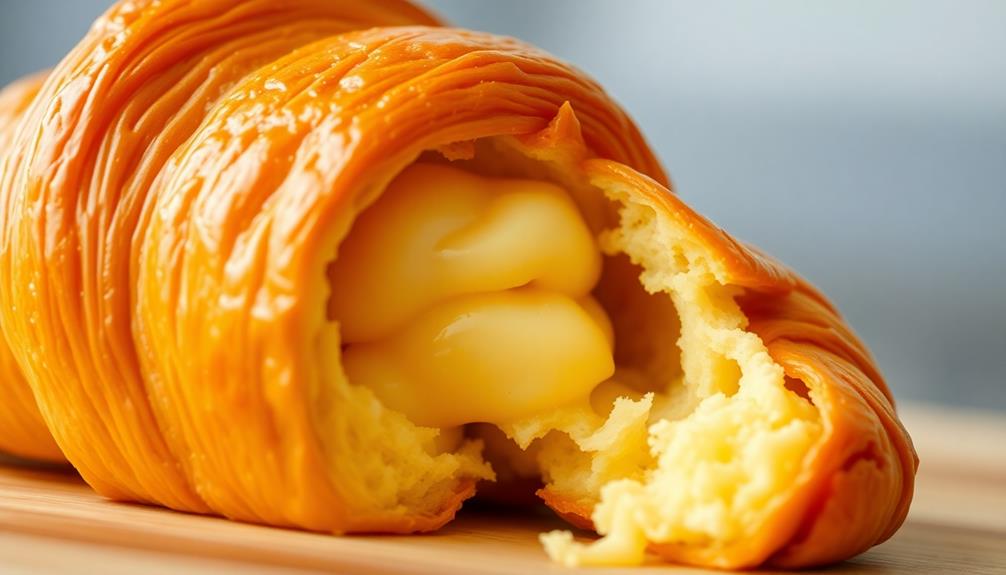
Now, let's dive into the cooking steps!
First, you'll need to make a yeast mixture.
Then, roll out the dough into a large rectangle.
Next, fold the dough into three neat layers.
Finally, spread chilled butter evenly over the dough and repeat the folding and chilling process.
Get ready for flaky, buttery perfection!
Step 1. Make Yeast Mixture
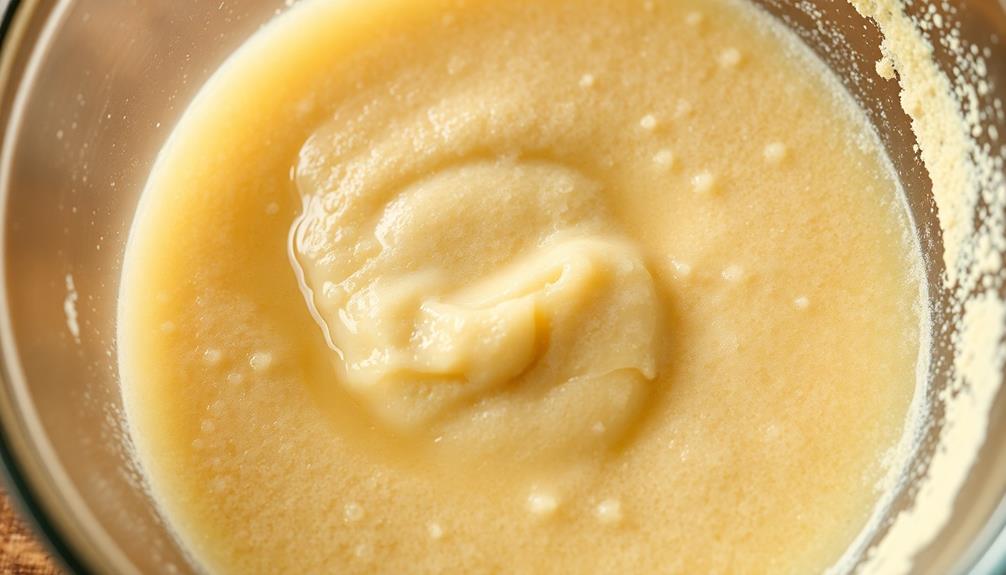
To begin the process, you'll need to make the yeast mixture. In a small bowl, combine the warm water, sugar, and yeast. Give it a gentle stir, then let it sit for about 10 minutes.
You'll see the mixture start to foam and bubble – that means the yeast is activated and ready to work its magic!
While the yeast is doing its thing, grab another bowl and whisk together the flour, salt, and sugar. This dry mixture will eventually get incorporated into the yeast mixture to form the dough.
Once the yeast is nice and frothy, pour it into the bowl with the dry ingredients. Use a wooden spoon or your hands to mix everything together until a shaggy dough starts to form.
Don't be afraid to get in there and knead the dough for a few minutes to bring it all together. You'll end up with a smooth, elastic ball of dough that's ready for the next step.
Step 2. Roll Out Dough Into Rectangle
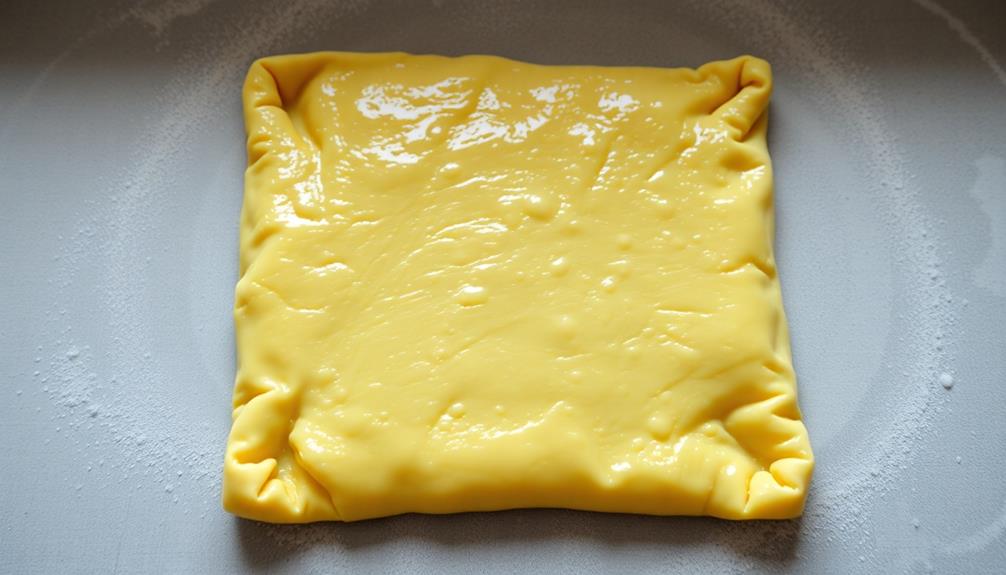
Once the dough has come together, you'll want to roll it out into a large rectangle on a lightly floured surface. Use a rolling pin to gently stretch and flatten the dough, being careful not to overwork it. Aim for a rectangle about 12 inches wide and 16 inches long, with a thickness of around 1/4 inch. If the dough starts to resist, let it rest for a few minutes before continuing.
As you roll, flip and rotate the dough frequently to ensure an even thickness. Lightly dust the surface and the dough with flour as needed to prevent sticking.
The goal is a smooth, uniform rectangle that's ready to be folded and layered with butter. Take your time and be patient – the key to flaky, buttery croissants is in the careful attention to this step.
Once you've achieved the desired size and shape, you're ready to move on to the next phase of creating those classic French pastries.
Step 3. Fold Dough Into Three Layers
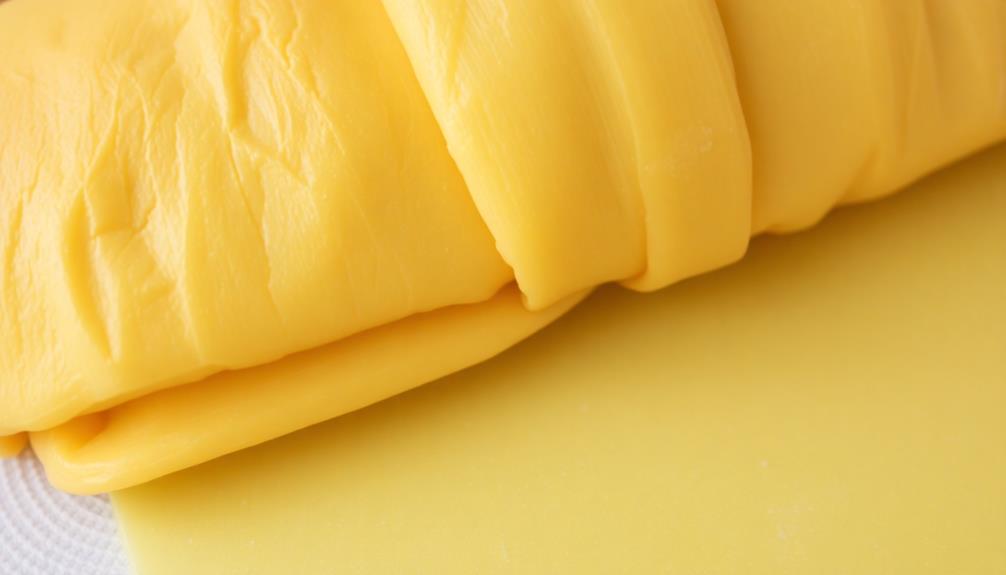
With the dough rolled out, you'll want to fold it into three even layers. Grab one of the shorter ends of the rectangle and fold it over the middle.
Then, take the other shorter end and fold it over the middle as well, creating a compact package. This folding process is crucial for building up the flaky layers in your croissants.
Now, use a rolling pin to gently roll out the dough again, being careful not to overwork it. You're aiming for a rectangular shape about 1/4 inch thick.
Repeat the folding process, taking one short end and bringing it to the middle, then the other short end on top. This second fold will further develop the delicate layers.
Finally, give the dough one last roll and fold, creating those beautiful, buttery, flaky croissant layers you're after. Wrap the dough in plastic and let it rest in the fridge before the next step.
The chilled, layered dough is now ready to be shaped into perfect croissants.
Step 4. Spread Chilled Butter Over Dough

After chilling the layered dough, you'll need to spread cold, cubed butter over the surface. This is a crucial step in creating those delightfully flaky layers we all love in a classic French croissant.
Take your chilled butter and cut it into small, even cubes. Gently place the cubes all over the dough, making sure to cover every inch. Use your fingertips to lightly press the butter into the dough, taking care not to smear it. You want the butter to remain in distinct pieces, not blended into the dough.
Once the butter is evenly distributed, fold the dough into thirds, like you did earlier. This will encase the butter between the dough layers. Chill the dough again before the next step.
The cold butter is key to achieving those melt-in-your-mouth, buttery flakes in your homemade croissants. Take your time and handle the dough gently to ensure the perfect texture.
Step 5. Repeat Folding and Chilling Process
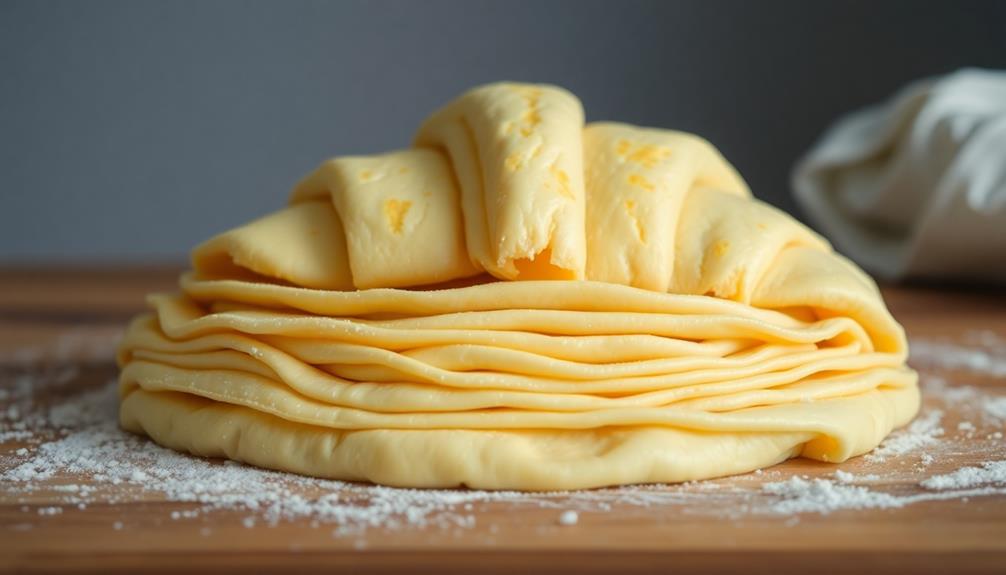
The dough now requires several more rounds of folding and chilling to create those delicate, flaky layers.
First, lightly flour your work surface and gently roll the dough into a long rectangle, about 1/2-inch thick. Fold the dough into thirds, like a letter, then turn it 90 degrees and roll it out again. Repeat this process 3-4 times, chilling the dough for 30 minutes between each round.
This folding and chilling technique builds hundreds of paper-thin layers of butter within the dough, which is the secret to achieving that classic croissant texture.
Don't be afraid to use plenty of flour to prevent the dough from sticking. After the final fold, wrap the dough tightly and refrigerate for at least 2 hours, or up to 2 days.
The extended chill time allows the gluten to relax, making the dough easier to work with when you're ready to shape your croissants. Stay patient and focused – this step is crucial for creating those melt-in-your-mouth, perfectly flaky croissants.
Final Thoughts

Crafting flawless butter croissants may seem daunting, but with the right approach, you'll be baking bakery-worthy pastries in no time. The repeated folding and chilling process you've just mastered is the key to achieving those delicate, flaky layers.
Now, it's all about attention to detail and a little patience. As you prepare to shape and bake your croissants, remember to work gently, handling the dough as little as possible to preserve those precious pockets of butter.
When shaping, use a light touch and avoid overworking the dough, which can compromise the texture. And when baking, keep a close eye – those golden, buttery beauties can go from perfect to overdone in the blink of an eye.
The reward for your efforts? Warm, flaky croissants that melt in your mouth, filling your kitchen with the irresistible aroma of freshly baked pastry.
Serve them alongside a steaming cup of coffee, and savor the fruits of your labor. With a little practice, you'll be turning out croissants that rival the best Parisian boulangeries.
Frequently Asked Questions
How Long Do Homemade Croissants Stay Fresh?
Homemade croissants will stay fresh for up to 3 days when stored at room temperature in an airtight container. For longer freshness, you can freeze them for up to 2 months.
Can I Freeze Unbaked Croissant Dough?
You can freeze unbaked croissant dough. Simply shape the dough, place it on a baking sheet, and freeze until firm. Once frozen, transfer the dough to an airtight container or bag and store for up to 2 months.
What's the Best Way to Reheat Leftover Croissants?
The best way to reheat leftover croissants is to preheat your oven to 350°F, place the croissants on a baking sheet, and bake for 5-7 minutes until heated through. This will help restore their crisp texture and flaky layers.
Can I Use Margarine Instead of Butter?
While you can use margarine instead of butter, it won't provide the same rich, buttery flavor or flaky texture that makes croissants so delicious. Butter is the traditional and preferred fat for authentic croissants.
How Do I Achieve a Shiny, Golden Crust?
To achieve a shiny, golden crust, brush the croissants with an egg wash before baking. The egg will create a beautiful shine and help the croissants turn a lovely golden-brown color as they bake.
